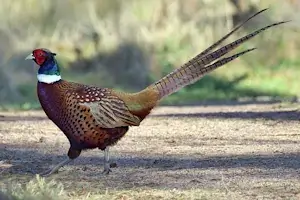Introduction: Keeping Pheasants as Special Animals
Pheasants are elegant and colorful birds that fascinate many hobbyists due to their exotic appearance and unique behavior. Whether kept as ornamental birds, for meat production, or for nature observation, keeping pheasants requires expertise, patience, and an appropriate environment. In this article, you’ll learn everything you need to know about pheasant keeping, from selecting the right species to designing the enclosure, to their care and feeding.
1. Pheasants: An Overview of Their Species and Characteristics
Popular Pheasant Species for Keeping
There are over 50 pheasant species worldwide, but not all are suitable for keeping. The most popular species include:
- Golden Pheasant (Chrysolophus pictus): Vibrantly colored and relatively easy to care for.
- Reeves Pheasant (Syrmaticus reevesii): Impressive tail feathers, requires plenty of space.
- Diamond Pheasant (Chrysolophus amherstiae): Colorful, ideal for experienced keepers.
- Common Pheasant (Phasianus colchicus): Robust and versatile, often kept for breeding.
Character and Behavior
Pheasants are shy and territorial animals. They prefer a calm environment and feel most comfortable in natural enclosures.
- Social Structure: In the wild, they typically live in small groups or pairs.
- Activities: Pheasants love scratching, flying, and exploring their surroundings.
2. Enclosure Design: The Habitat for Pheasants and Aviary
Space Requirements and Protection
A spacious and secure enclosure is crucial for the well-being of pheasants. To avoid territorial fights, it is recommended not to keep two males in the same aviary.
However, keeping one male with several females in the same enclosure is not a problem.
The optimal environment for pheasants combines both a stall enclosure and an aviary.
- Size: At least 20 m² per pair.
- Fence: A height of 2 meters is recommended to prevent escape and protect against predators.
- Roof: A net or mesh protects from birds of prey and other threats.
Enclosure Setup
Pheasants need a natural-like environment to feel comfortable.
- Planting: Bushes, grasses, and trees provide hiding spots and shade.
- Ground Design: Sand or soil is ideal for scratching.
- Shelter: Small huts or sheltered areas for resting at night.
Protection from Weather
While pheasants are hardy, they require protection from extreme weather conditions.
- Winter: Insulated shelters with straw or hay bedding.
- Summer: Sufficient shaded areas and access to water.
3. Feeding Pheasants
Basic Feeding Principles
A balanced diet is essential for the health of pheasants.
- Basic Feed: Special pheasant feed or poultry pellets.
- Supplementary Feed: Fruits, vegetables, seeds, and insects like mealworms.
- Green Feed: Grasses, herbs, and dandelions complement the diet.
Feeding Tips
- Feeding Stations: Place in a protected area to avoid contamination.
- Water: Fresh water must be available at all times.
Feeding During the Breeding Season
During breeding, pheasants need protein-rich food to support their energy reserves.
4. Care and Health
Hygiene in the Enclosure
A clean enclosure is crucial for disease prevention.
- Cleaning: Remove droppings and leftover feed daily.
- Bedding: Regularly change straw or sand.
Common Diseases and Prevention
Pheasants can be susceptible to parasites and infections.
- Parasites: Mites and worms are common. Regular checks are important.
- Immunization: In some cases, vaccination against poultry diseases may be necessary.
Signs of Illness
- Apathy
- Diarrhea
- Weight loss
If you notice any abnormalities, consult a veterinarian.
5. Pheasant Breeding
Breeding Season
The breeding season begins in spring and lasts until early summer.
- Nesting Areas: Provide the hens with quiet and sheltered spots for their nests.
- Eggs: A hen lays 8–12 eggs per year.
Artificial Incubation
If natural breeding is not possible, the eggs can be incubated artificially.
- Temperature: About 37.5°C.
- Humidity: 50–60%.
Raising Chicks
The chicks need warmth and specialized chick feed during their first weeks.
6. Legal Requirements and Tips for Beginners
Laws and Regulations
Make sure to check regional regulations regarding pheasant keeping. In some countries, permits are required.
Tips for Beginners
- Start with an easy-to-care-for species like the Golden Pheasant.
- Plan enough space and time for proper care.
- Connect with other keepers or experts.
7. Benefits of Keeping Pheasants
Aesthetics and Enjoyment of Nature
Pheasants bring elegance and a touch of exoticism to your garden.
Natural Pest Control
Pheasants eat insects and contribute to biological pest control.
Sustainable Meat and Egg Production
Pheasant keeping can also be used for self-sufficiency in meat and egg production.
Conclusion: Keeping Pheasants – A Rewarding Hobby
Keeping pheasants is demanding but extremely rewarding. With enough space, a natural environment, and a balanced diet, these elegant birds quickly feel at home. Whether for breeding, as ornamental birds, or simply for enjoyment – pheasants enrich any environment and offer a fascinating experience for animal lovers.en Tiere schnell wohl. Ob zur Zucht, als Ziergeflügel oder einfach zur Freude – Fasane bereichern jedes Umfeld und bieten ein faszinierendes Erlebnis für Tierliebhaber.

